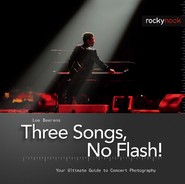There is only one piece of advice I can give you: if you want to make a good shot of the screens, ignore the artist on stage. That means you only concentrate on what is happening on the screens and take a shot of that. Most of the time there is a delay of about half a second, but this differs per screen. If the artist is slightly ahead of the picture on the screen, it will not be a disturbing factor in your photo.
Most of the time you will have to leave the venue or at least take your photo gear outside after the first three songs. If that is not the case, walk around the venue and take total shots of the stage from different angles. Many halls and stages offer you original and dynamic shots. For instance, you can check for a high standpoint so you can look down onto the stage.
Above is a shot of the sold-out Paradiso in Amsterdam. The visual effect is emphasized by the use of the widest possible angle. At left is Tony Bennett in concert at the Congresgebouw in The Hague. Here I chose a light telephoto so I would only get the full width of the stage and background projection and nothing of the venue itself.



